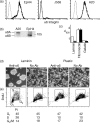Alpha6-integrin is expressed on germinal centre B cells and modifies growth of a B-cell line
- PMID: 15056376
- PMCID: PMC1782434
- DOI: 10.1111/j.1365-2567.2004.01824.x
Alpha6-integrin is expressed on germinal centre B cells and modifies growth of a B-cell line
Abstract
The production of high-affinity antibodies requires diversification of the antibody repertoire by somatic hypermutation followed by selection of those B cells bearing the highest affinity antibodies. Whilst many surface molecules that mediate the cell-cell interactions required for germinal centre formation have been identified, little is known of the importance of interactions with components of the extracellular matrix, i.e. fibronectin, collagen and laminin. We demonstrate that the laminin-binding alpha6-integrin is expressed on germinal centre B cells and is induced during the in vitro activation of naïve splenic B cells. A laminin network is demonstrated within the germinal centre. Analysis of an alpha6-integrin-expressing mouse B-cell line, A20, demonstrates that this molecule is essential for binding to laminin, and that blocking by anti-alpha6-integrin immunoglobulin causes loss of adhesion associated with an increase in proliferation. There is no correlation with changes in BCL-6 or Blimp-1 expression, suggesting that alpha6-integrin does not play a role in differentiation.
Figures





Comment in
-
Positioning the immune system: unexpected roles for alpha6-integrins.Immunology. 2004 Apr;111(4):381-3. doi: 10.1111/j.0019-2805.2004.01838.x. Immunology. 2004. PMID: 15056373 Free PMC article. Review. No abstract available.
References
-
- MacLennan I, Liu Y-J, Johnson G. Maturation and dispersal of B-cell clones during T cell-dependent antibody responses. Immunol Rev. 1992;126:143. - PubMed
-
- Jacob J, Kelsoe G, Rajewsky K, Weiss U. Intraclonal generation of antibody mutants in germinal centres. Nature. 1991;354:389. - PubMed
-
- Kepler T, Perelson A. Cyclic re-entry of germinal centre B cells and the efficiency of affinity maturation. Immunol Today. 1993;14:412. - PubMed
-
- Hynes R. Integrins: bidirectional allosteric signalling machines. Cell. 2002;110:673. - PubMed
-
- Lu T, Cyster J. Integrin mediated long-term B cell retention in the splenic marginal zone. Science. 2002;297:409. - PubMed
Publication types
MeSH terms
Substances
Grants and funding
LinkOut - more resources
Full Text Sources
